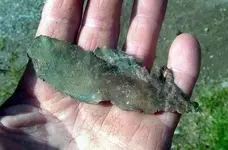hmmm
Hero Member
- Joined
- Jun 9, 2007
- Messages
- 830
- Reaction score
- 98
- Golden Thread
- 0
- Primary Interest:
- All Treasure Hunting
Hi all
I found a steal bar that has a layer of copper coating it. It is in rocks in a salt water lagoon, i figure it is for a tie up for ships but i do not know what culture used it. Any ideas.



I found a steal bar that has a layer of copper coating it. It is in rocks in a salt water lagoon, i figure it is for a tie up for ships but i do not know what culture used it. Any ideas.

COME ON GUYS

there has to be someone who has some incite on this.
It is in the rocks to the right of the plate i am holding, the plate is from the early 1900's.
But there must be overlapping history.


The bar is wedged into a crevas in the rock and looks as if it was placed as a tie up loop, possibly for ships or docks.

there has to be someone who has some incite on this.
It is in the rocks to the right of the plate i am holding, the plate is from the early 1900's.
But there must be overlapping history.
The bar is wedged into a crevas in the rock and looks as if it was placed as a tie up loop, possibly for ships or docks.
Last edited:










